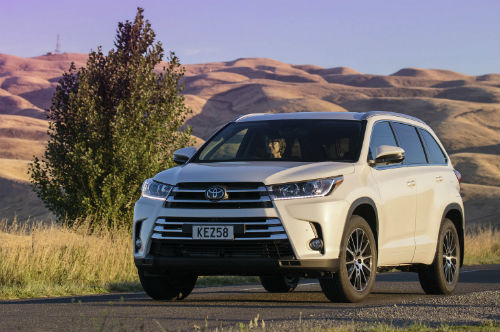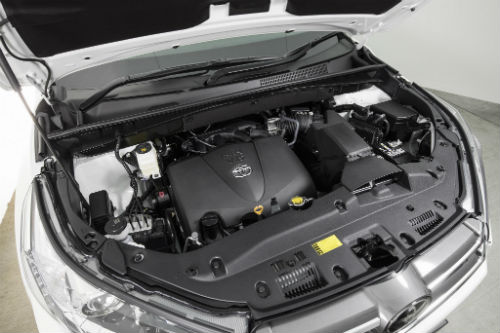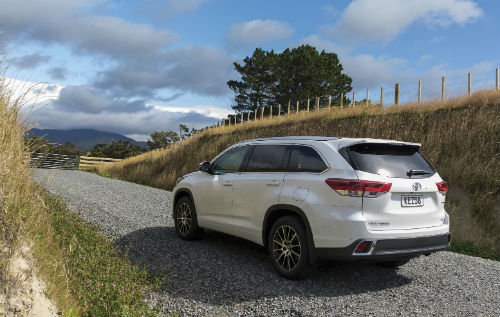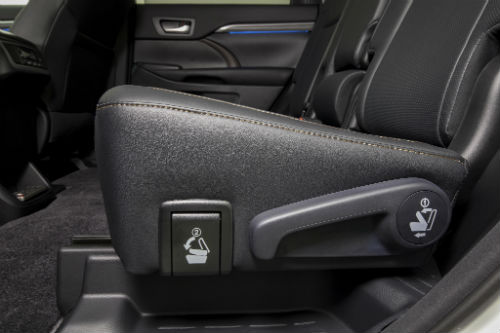Thursday July 20, 2017
For: Smooth drivetrain, roomy interior, excellent build and finish.
Against: More expensive and less well-kitted than emergent rivals, styling pizzazz restricts to exterior, foot-operated parking brake.
By Richard Bosselman
DIESEL, latest safety systems and smart infotainment solutions – these have been particularly sought-after in the sports utility sector.
So how come a vehicle that only sells in V6 petrol format, restricts the latest in-vogue active safety features to just the most expensive of its three trim levels and steadfastly cold-shoulders the hottest phone-tethered hard and software is leading the pack?
Well, if you know Toyota, you know who it sells to and how. So, put it this way, if fleet registrations were removed from the equation, and only genuine private purchases were considered, then the Highlander would fall from first place to somewhere in the middle of the pack, with the Hyundai Sante Fe instead holding top spot and the Mazda CX-9 coming up fast behind.
But that’s not how the system works: Sales are sales and all are counted. And Toyota sells a LOT of Highlanders into rental car servitude.
That’s not to say it is ostracised by private buyers. They also support this rig, albeit in much lower strength than the support base that some rival models achieve.
The strengths that would put a Highlander into your driveway are easily cited. It has substantial size on its side, which in turn means decent interior space. Also, it has the smoothest V6 petrol engine in this class. Actually, beyond the class: There are plenty of much more expensive SUVs that aren’t as well served.
Another Highlander plus is its mixed heritage. America is Highlander heartland. Centring global production from a vast factory at Princeton, Indiana, is logical because this model is primarily designed to meet American tastes. But it’s still a Toyota, so you win there too, the plant achieving a material quality and exacting fit and finish that is typical of Japan’s biggest, most profitable car maker.
The ace card played by all models is that 3.5-litre V6; it really is an incredibly refined powerplant very well-suited to its new marriage partner, an eight-speed automatic.
However, even though new direct injection technology and a higher compression ratio bumps up power, to 218kW (a 17kW lift) and torque also climbs, by 13Nm to 350Nm of torque, it doesn’t support argument that displacement always wins out. CX-9 shows how times have changed: Mazda’s rival dropped a V6 in favour of a 2.5-litre four cylinder and while power from that turbocharged direct injection petrol unit is less sensational, at 170kW (from 201kW previously) it has masses of torque, with 420Nm. And you’d have to say that muscle makes more sense for this kind of vehicle.
Nonetheless, the Toyota unit is more than a match for the 2100kg kerb weight and enhances Highlander’s appeal as a vehicle with effortless cruising and overtaking abilities. The towing capacity of 2.0-tonnes braked is also acceptable, too.
The new transmission keeps it cruisy, though the primary reason for its inclusion is to offset a long-running issue, excessive fuel use.
Trying to achieve Toyota’s claimed 9.5l/100km consumption (9.1l/100km in two-wheel-drive models) sees the transmission programmed so that it pushes for the highest gear possible in the shortest time span and the all-wheel-drive regressing to rear-drive whenever it senses opportunity.
The engine’s torque is beneficial to the crusade for cruising with minimal revs, providing the road condition is also conducive. But laidback flat freeways are far from frequent in my part of the world; so inevitably, opportunity for it to all but freewheel for ages at a constant 100kmh was rare.
So, accordingly, I wasn’t surprised that the drinking rate never came close to the cited figures. In general traffic, you’d find it was rarely settling in top gear for long. Going with the flow means getting on and off the power. With Highlander, kick down the throttle and it will rapidly reposition back to sixth or, if you’re chasing a quick overtake, fifth.
Restricting the vehicle to a city-intensive commute is also harmful to its economy; a day of city running saw the test vehicle’s drinking rate climb into the mid-teens. Not sure I could live with that.
The mid-spec GXL on test provisioned in its $70,490 all-wheel-drive form also provides in an alternate $66,490 front-drive format that is slightly less thirsty, but would you want it? I’d suggest you’ll feel, and appreciate, that $4k worth of extra traction on any winter’s day and, obviously, the AWD variety offers a much better opportunity to reach those skifield carparks.
Highlander’s dynamic skill set prioritises comfort over cornering capability, and it simply isn’t as driver-centric as the Mazda or the Hyundai. But it rides ride feels well, ironing out most surface imperfections and isolating occupants from external road noise and wind noise, and the steering offers ample precision.
More patently ‘American’ is the cabin theme: Oversized centre cupholders that’ll hold 1.25 litre bottles (though they’re perhaps really shaped for giant slurpee cups) and are too large for conventional takeaway coffee cups, a foot-operated park brake that’s in just the right place to smack your ankle against, broad front seats, a slabby, angular dashboard design and huge flat shelf to hold the world’s biggest cell phones (and perhaps some boxes of pistol ammunition) all serve to remind that the primary customer base has specific expectations.
There’s seating space for five people across the first two rows, and the rearmost chairs are easily accessed via second row seats even though these lack the tumbling function some rivals provide, but instead only slide forward and tilt. All three rows receive face-level air vents.
With the rearmost chairs in place, boot space is a modest 195 litres – so if you’re seven-up and aiming for a weekend away, get a trailer or a roof pod. Your bags are definitely not going to all fit inside.
Leave a passenger behind, though, and there’s potential to free up a lot more room; just dropping the rearmost seats creates 529 litres’ space.
So it’s functional and flexible. What the interior lacks is design flair. You can understand why this car makes for good rental fodder – the surfaces are all easily clean and highly resistant to marks or knocks.
At the same token, the cabin is very much a grey zone and, at GLX level, looks quite nondescript. That centre screen is massively under-utilised and the hard-wired function buttons either side of the display look budget and are finicky to use. Some of the same functions can be accessed via a matching colour screen in the driver’s digital instrument cluster. Weirdly, this is also the pathway to resetting the transmission into its performance mode: Not a logical concept.
Toyota’s intransigence to Apple CarPlay or Android Auto leaves it looking increasingly out of step, not least because its own in-house infotainment package is far from special and the functionality and interactivity of those popular systems is so proven. To be fair, Mazda also needs to step up as well. Another funny thing about the Highlander: It has just the one USB port. Remarkable! You’d think in America all seven occupants would want their own ports. There are some old-style 12V ciggie lighter power outlets.
In the US, all versions of the Highlander come equipped with a pre-collision system, autonomous emergency braking, active cruise control, lane departure alert (with steering control and sway warning), rear cross-traffic alert, blind spot monitor and auto high beam.
In New Zealand, however, those features restrict to the flagship $81,490 Highlander Limited, which also stands alone in provisioning a four-camera panoramic view monitor, front parking sensors and rear-cross-traffic alert.
At Highlander’s launch, four months ago, Toyota New Zealand said it was trying to find a way of transferring the same package to the GXL, but that has yet to happen.
What other seven-seaters have AEB? Two that are way cheaper and achieving a lot of notice here: There’s the new European champion, Skoda’s Kodiaq, and the CX-9 – another Japanese product made in America to suit American tastes.
Mazda doesn’t seek to sell its rig to fleets; it’s eye is firmly on private buyers. And, frankly, their car has the Highlander trumped on this side of things.
Mazda manages to make blind-spot monitoring, rear cross-traffic alert, autonomous city braking, rear parking sensors and LED headlights standard to all three CX-9 editions. Yet dearest edition, also called the Limited, cost $495 less than the cheapest Highlander – even though it adds in a radar cruise control, smart brake support at open-road speeds, lane-keeping alert with steering assistance, driver attention alert.
Comparison seems inevitable even though the engine approaches are different.
Perhaps the safety suite is of less consideration to the Highlander’s fleet customers, but I would suggest private buyers should think more carefully, given that AEB alone is now being championed by independent safety organisations, including ANCAP, which the NZ Government part-funds.
At the moment, Toyota’s product stands isolated. Which probably won’t make a dot of difference so long as it maintains appeal as a primary rental choice.
(Note: The images with this review are of the Highlander Limited).


